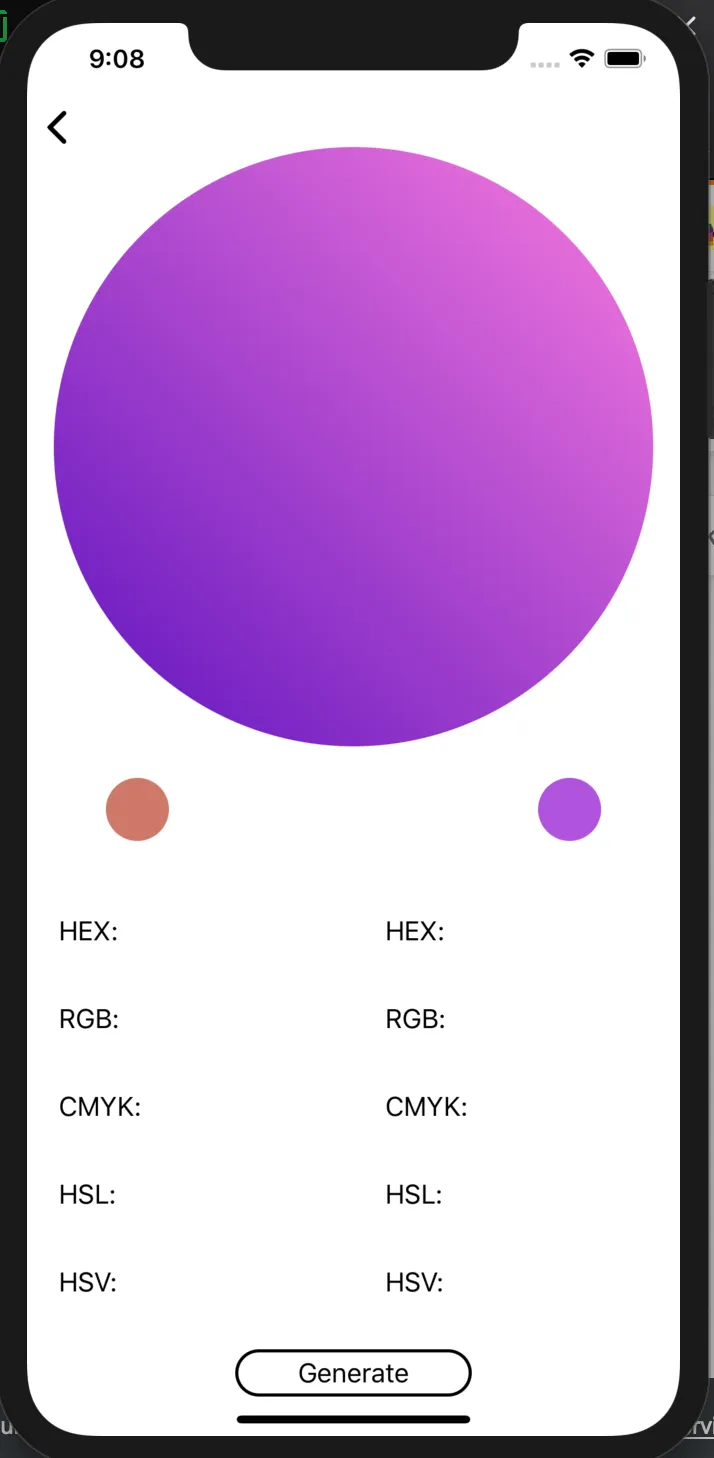当用户点击按钮时,它会随机使用颜色来创建大圆中的渐变效果。在大圆下方有两个小圆显示用于渐变的实色。一开始它们都正确地显示(主圆是随机小圆颜色的渐变),但当我点击按钮时,只有小圆改变颜色,大圆保持相同的渐变颜色。
扩展和视图控制器:
我尝试的是将
扩展和视图控制器:
extension UIView {
func setupGradientBackground(colorOne: UIColor, colorTwo: UIColor) {
let gradientLayer: CAGradientLayer = CAGradientLayer()
gradientLayer.colors = [colorOne.cgColor, colorTwo.cgColor]
gradientLayer.locations = [0.0, 1.0]
gradientLayer.startPoint = CGPoint(x: 0.0, y: 1.0)
gradientLayer.endPoint = CGPoint(x: 1.0, y: 0.0)
gradientLayer.frame = self.bounds
self.layer.insertSublayer(gradientLayer, at: 0)
}
}
extension UIColor {
static var random: UIColor {
return UIColor(red: .random(in: 0...1), green: .random(in: 0...1), blue: .random(in: 0...1), alpha: 1.0)
}
}
class GradientController: UIViewController {
let gradientView = GradientView()
let leftGradientColor: UIColor = .random
let rightGradientColor: UIColor = .random
}
override func viewDidLoad() {
super.viewDidLoad()
view = gradientView
newGradient()
}
func newGradient() {
gradientView.mainCircleView.setupGradientBackground(colorOne: leftGradientColor, colorTwo: rightGradientColor)
gradientView.colorCircleLeftView.backgroundColor = leftGradientColor
gradientView.colorCircleRightView.backgroundColor = rightGradientColor
gradientView.gradientGenerateButton.addTarget(self, action: #selector(randomGradient(sender:)), for: .touchUpInside)
}
@objc func randomGradient(sender: UIButton)
{
let leftGradient = UIColor.random
let rightGradient = UIColor.random
gradientView.colorCircleLeftView.backgroundColor = leftGradient
gradientView.colorCircleRightView.backgroundColor = rightGradient
//Here is where it's not changing colors. Doesn't seem like the VC recognizes it in this function
gradientView.mainCircleView.setupGradientBackground(colorOne: leftGradient, colorTwo: rightGradient)
}
查看:
class GradientView: UIView {
//circle's UIView code in Extensions
let mainCircleView = UIView().circleView(width: 380, height: 380)
let colorCircleLeftView = UIView().circleView(width: 40, height: 40)
let colorCircleRightView = UIView().circleView(width: 40, height: 40)
...
func setupLayout() {
...
}
}
我尝试的是将
mainCircleView的颜色更改为纯UIColors,例如gradientView.mainCircleView.setupGradientBackground(colorOne: .red, colorTwo: .orange),以查看主圆在func newGradient()和@objc func randomGradient(sender: UIButton)中是否都会更改为这些颜色。只有在我手动设置的func newGradient()中才会更改,这意味着VC在@objc func中无法识别主圆,但我不知道如何解决它...
感谢您的任何帮助!
